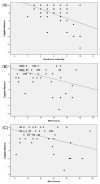Cognitive Reserve and Its Associations with Pain, Anxiety, and Depression in Patients with Chronic Migraine: A Retrospective Study
- PMID: 40806814
- PMCID: PMC12347591
- DOI: 10.3390/jcm14155193
Cognitive Reserve and Its Associations with Pain, Anxiety, and Depression in Patients with Chronic Migraine: A Retrospective Study
Abstract
Background/Objectives: Cognitive dysfunction is frequently observed in chronic migraine (CM) patients, but the contributing medical and psychological factors remain unclear. This study investigated associations between the cognitive reserve and medical, psychological, and lifestyle factors in individuals with CM. Methods: A retrospective review was conducted at a tertiary referral center in Taiwan. Cognitive function was evaluated via the mini-mental state examination (MMSE), while anxiety and depression were evaluated via the Beck Anxiety and Depression Inventories. Clinical variables included monthly headache days, headache intensity (numerical rating scale), migraine-related disability, and use of preventive medications. Multivariable linear regression analyses were performed to identify independent predictors of the cognitive reserve after adjusting for relevant covariates. Results: Among 50 participants (86.0% women; mean age 42.48 ± 13.47 years), six (12.0%) exhibited objective cognitive impairment (MMSE < cutoff). After a covariate adjustment, higher headache intensity was significantly associated with a lower cognitive reserve in anxiety and depression models. Patients with objective cognitive impairment reported significantly higher levels of pain, anxiety, and depression. Conclusions: The headache intensity, anxiety, and depression were significantly linked to a lower cognitive reserve in CM patients. These findings highlight the importance of incorporating routine psychological and cognitive assessments in CM care and suggest potential targets for integrative treatment strategies.
Keywords: cognitive impairment; headache intensity; mental health; neurocognitive assessment; psychiatric comorbidity; psychological distress; quality of life.
Conflict of interest statement
The authors declare no conflicts of interest.
Figures


Similar articles
-
Psychological therapies for the management of chronic and recurrent pain in children and adolescents.Cochrane Database Syst Rev. 2018 Sep 29;9(9):CD003968. doi: 10.1002/14651858.CD003968.pub5. Cochrane Database Syst Rev. 2018. PMID: 30270423 Free PMC article.
-
Prescription of Controlled Substances: Benefits and Risks.2025 Jul 6. In: StatPearls [Internet]. Treasure Island (FL): StatPearls Publishing; 2025 Jan–. 2025 Jul 6. In: StatPearls [Internet]. Treasure Island (FL): StatPearls Publishing; 2025 Jan–. PMID: 30726003 Free Books & Documents.
-
Psychological therapies (Internet-delivered) for the management of chronic pain in adults.Cochrane Database Syst Rev. 2014 Feb 26;2014(2):CD010152. doi: 10.1002/14651858.CD010152.pub2. Cochrane Database Syst Rev. 2014. PMID: 24574082 Free PMC article.
-
Psychological therapies for the management of chronic and recurrent pain in children and adolescents.Cochrane Database Syst Rev. 2014 May 5;2014(5):CD003968. doi: 10.1002/14651858.CD003968.pub4. Cochrane Database Syst Rev. 2014. Update in: Cochrane Database Syst Rev. 2018 Sep 29;9:CD003968. doi: 10.1002/14651858.CD003968.pub5. PMID: 24796681 Free PMC article. Updated.
-
Psychological therapies (remotely delivered) for the management of chronic and recurrent pain in children and adolescents.Cochrane Database Syst Rev. 2015 Mar 23;3(3):CD011118. doi: 10.1002/14651858.CD011118.pub2. Cochrane Database Syst Rev. 2015. Update in: Cochrane Database Syst Rev. 2019 Apr 02;4:CD011118. doi: 10.1002/14651858.CD011118.pub3. PMID: 25803793 Free PMC article. Updated.
References
-
- Headache Classification Committee of the International Headache Society (IHS) The International Classification of Headache Disorders. 3rd ed. Volume 38. Sage; Thousand Oaks, CA, USA: 2018. pp. 1–211. Cephalalgia. - PubMed
-
- Wang Y.F., Wang S.-J., Huang Y.H., Chen Y.-T., Yen Y.-C., Shia B.-C., Tsai C.-W., Chan H.-F., Panni T., Dell G. Treatment pattern and health care resource utilization for Taiwanese patients with migraine: A population-based study. Front. Neurol. 2023;14:1222912. doi: 10.3389/fneur.2023.1222912. - DOI - PMC - PubMed
LinkOut - more resources
Full Text Sources

